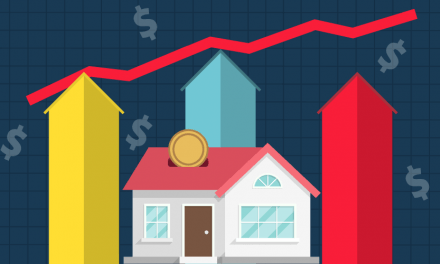The yield spread indicates the likelihood of a recession or recovery one year forward. The spread equals the difference between the short-term borrowing rate set by the Federal Reserve (the Fed) and the interest rate on the 10-year Treasury Note, determined by bond market activity.
The yield spread has remained in negative territory since November 2022, averaging -0.79 in November 2023. Today’s profoundly negative yield spread is near its lowest level since 1981, when the Fed was waging its last acute battle against inflation and the economy was tilting into a deep recession.
Today’s ongoing inversion is the result of higher short-term interest rates stimulated by the Fed and lower long-term rates as the economy slows and bond market investors see fewer safe investment opportunities. The Fed will continue its rate strategy until it senses inflation is under control. Only then will the Fed reign in its rate increases. Meanwhile, following 18 months of FRM rate bumps, the housing market cooldown has set in, and a recession is inevitable.
While an undeclared recession has already caused home sales volume to spiral and prices to pull back in 2022-2023 — the timing of the yield spread inversion has the economic recession officially arriving in late-2023 or early 2024.
The housing market will continue to see declining sales volume in 2024, with prices bottoming around 2026, absent a brief seasonal uptick for pricing in Spring 2024.
Updated December 14, 2023. Original copy released March 2010.

Chart update 12/14/23
| Nov 2023 | Oct 2023 | Nov 2022 | |
| Yield Spread | -0.79 | -0.55 | -0.33 |
Confidence about the year to come
To you stalwart members of the real estate profession, a gift: the ability to forecast the probability of future recessions and rebounds, one year forward. This famed crystal ball is the yield curve spread, also simply called the yield spread.
Don’t let the name yield spread put you off. It is not related to the deceptive yield spread premium (YSP) kickback mortgage lenders paid in times past.
The yield spread reflects economic conditions as interpreted by bond market investors and Fed economists. To use the yield spread, all the layperson has to do is locate and understand what the current yield spread margin imports.
That knowledge is provided to you in this article.
The long-term market rate
The yield spread figure is the difference between two key interest rates:
- the 10-year Treasury note (T-note) rate (or long-term rate) set by bond market investors; and
- the 3-month Treasury bill rate (or short-term rate) set by the Federal Reserve (the Fed).
To make a profit on their long-term investments, bond market investors consider how the Fed’s monetary policy will impact future markets. These millions of private individual forecasts of future economic conditions are translated into a ready gauge for determining future market conditions – the wisdom of the crowd.
Their considerations encompass two discrete elements:
- the perceived future rate of inflation, called the inflation risk premium, a figure built into the 10-year (T-note) rate; and
- the desired fixed rate of return on the investment in excess of the future rate of inflation, called the real rate of earnings.
The short-term market rate
The second piece of information needed to calculate the yield spread is the interest rate on the 3-month Treasury bill. This interest rate is managed by the Fed as the base price of short-term borrowing, their primary tool for keeping the U.S. economy balanced.
The Fed has direct control over this short-term rate through its Federal Funds Rate. The Fed can:
- lower interest rates and stimulate economic growth to stave off deflation and economic stagnation; or
- raise interest rates and slow economic growth to fight inflation and excess demands for labor.
Related article:
Collectively, the Fed’s use of short-term interest rates and other infusions and withdrawals of dollars to control the economy is known as monetary policy.
Related article:
Interplay between the treasury rates = the yield spread
Calculating the yield spread is simply a matter of subtracting the 3-month T-bill rate from the 10-year T-note rate.
Generally, a low or declining yield spread indicates a less vigorous economy one year forward. This declining yield spread is a result of bond market investors seeing less future growth resulting from the Fed’s short-term rate activity and other economic interruptions or stimulus – the global economy’s relationship to ours.
On the flip-side of an economic cycle, a higher or rising yield spread indicates a more vigorous future economy. While good for bond market investors whose actions are full-speed-ahead for profit, a too-high yield spread (and its resulting boom) poses a danger for consumer inflation. When this occurs, the Fed acts to curtail the growth of future jobs and stabilize consumer prices by raising short-term rates.
An over-correction can potentially send the yield spread into low or negative levels. When the yield spread goes negative, or inverts, a recession follows 12 months later. Most recessions are Fed instituted to correct for economic distortions.
A yield spread inversion is the result of:
- the bond market forecasting a future downturn in the economy; and/or
- the Fed raising short-term interest rates to correct inflation or loose market conditions.
Sometimes even a near-inversion is enough to signal a recession.
That crossover moment gives the real estate broker and agent another signal to adjust their conduct. At the crossover, agents can expect a reduced volume in sales (which will already be slipping), lending and leasing one year forward. Then, in another 12 months, there will be a drop in prices, loan rates and rents, the delay resulting from the sticky price phenomenon brought about by money illusions of sellers and landlords.
Reading the chart and current trends
In the above chart:
- the red line tracks the yield spread from January 1955 through today.
- The yield spread dips below zero when the short-term rate rises above the long-term rate. This is the inversion point.
- +1.21 is the point for which the probability of recession begins, as assigned by Fed economists. Yield spreads smaller than 1.21% predict successively greater probabilities of recessions one year forward.
In November 2022, the yield spread first went negative, remaining deeply negative a year later. This prolonged negative figure forecasts an economic recession to officially arrive heading into 2024.
The last time the yield spread was negative was in mid-2019, signaling the coming 2022 recession. Before 2019, the last time the yield spread was negative was in late 2006 when it hit -0.205%, forecasting the terrible 2008 recession.
The negative spread in late 2006 predicted a 40% chance of a recession to take hold one year forward, around the end of 2007. Then in December 2007, we formally entered the recession. Now we are well into the expansion period of the recovery with employment rising and a low unemployment rate. However, while all jobs lost during the recession have been recovered, not enough jobs have been added to make up for the increase in the working-age population since 2008.
Each time since 1960 that the yield spread went negative we were in a recession approximately 12 months later.
Going into 2020, the likelihood of a decline in general business and real estate activities over the next 12 months was already high as the spread dipped below zero in 2019. However, the added pressure of the global pandemic and financial crash pushed what was to be a normal recession into one of larger significance. The potential devastation was too much for the government to bear, and so an unprecedented level of stimulus was injected into the economy, ultimately pushing inflation to rise rapidly, setting up the economy for the next recession.
Fed efforts to prevent a recession
The Fed closely watched the yield spread in 2015 and kept the short-term rate low (essentially at zero). Their objective was to create an environment ripe for wage increases and steady consumer price inflation.
In late 2013, the Fed began to wind down its program of quantitative easing (QE3) in response to an improving job market, and finally ended QE3 in October 2014. Nonetheless, it vowed to keep short-term interest rates low until the job market has fully recovered.
However, the Fed finally increased the short-term interest rate by 0.25% in December 2015 and has since amped up its rate of increase. As a result of the bond market rates and the Fed’s short-term rate increase, the yield spread then started to decline.
Related article:
Real estate’s stake
Real estate was a key player contributing to the excesses that brought about the 2008 Recession and the financial crisis. The yield spread was clearly decreasing in the years prior to the implosion of the real estate bubble. This condition does not now exist.
The Fed’s concerted effort to raise short-term rates to lean against the excesses began mid-2004. However, it came too little too late, after allowing the market to go hog-wild for too long — an observation derived from hindsight.
Now, the collective efforts of in-the-know real estate professionals will nurse the real estate market back to health. Going forward, more and more brokers and agents need to understand the workings of the yield spread as a gauge of the economy’s direction for the coming 12 months. Only then, with this insight, will the industry-wide frenzy to over-build, over-price and over-sell be tempered.
Brokers and agents who track the yield spread will be given the foresight to shift their advice and spending routines before the changes in the market actually occur. In doing so they will seek out recession-proof niches of real estate (such as real estate owned (REO) sales, or property management) in which to weather the storm.



















I would like to convey my heartfelt gratitude for the excellent quality of the previously mentioned paper. Through careful consideration and planned execution, the author expertly developed an intellectually stimulating and stunningly impressive article.
This method is very good, you can try it
I use these instructions to improve my financial situation. Thank you for the truth.
Thank you for putting this information together and providing context for your analysis. I did note one minor error in the section Reading the chart and current trends: “the red line tracks the yield spread…” I believe this should be the blue line tracks the yield spread… Again, thank you for very clearly explaining the yield spread influence on our economy.
Your words have the power to inspire and educate.
I just read your article and I have to say, it was one of the best I’ve read in a long time. Your writing style is so engaging and the content was incredibly informative.